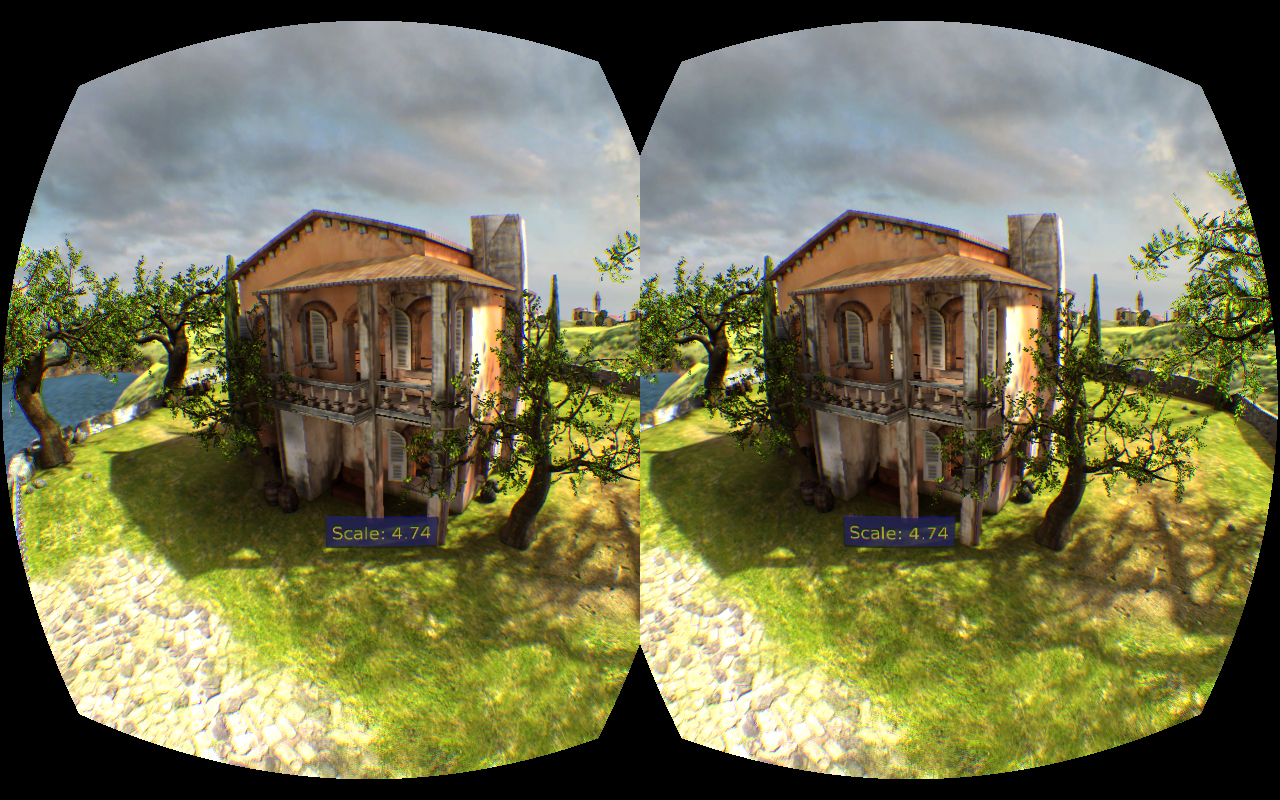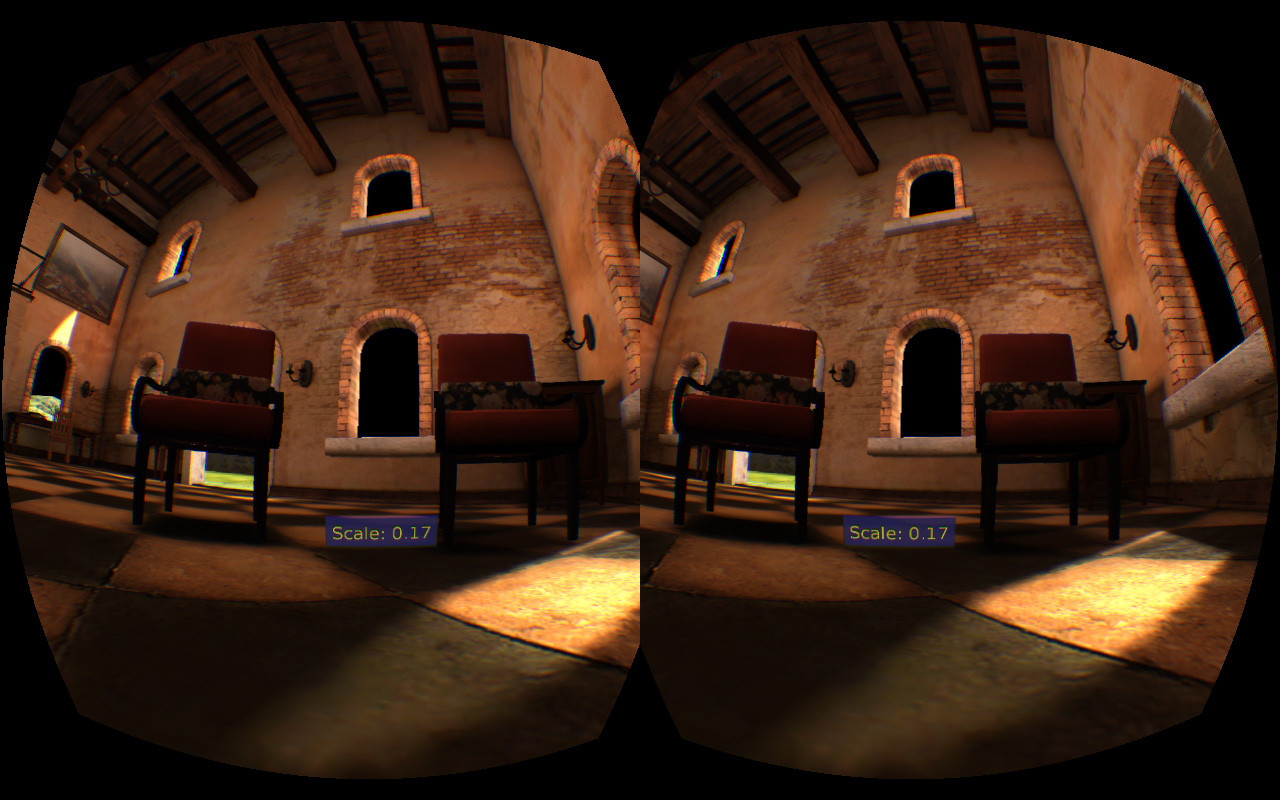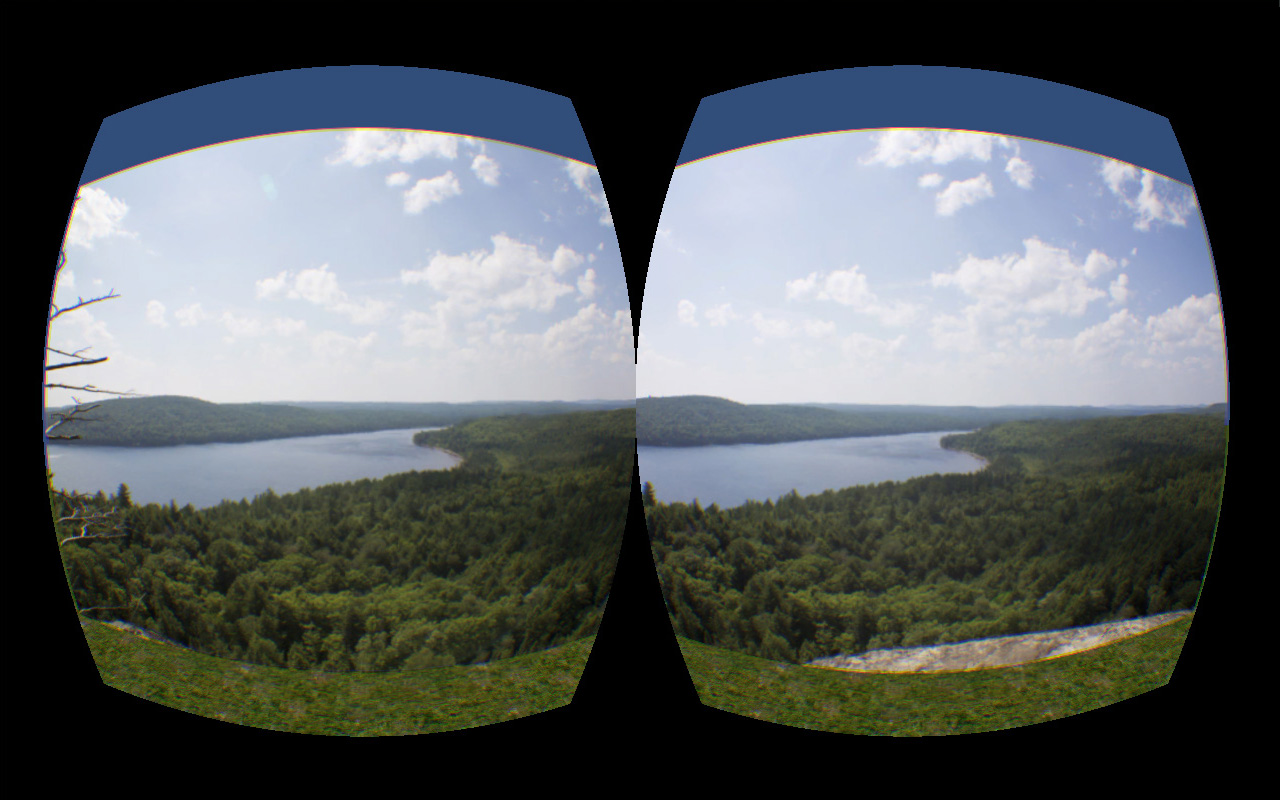The future is here! I recently got my hands on a pair of the awesome Oculus Rift VR goggles, and I am extremely excited. While the demo software is impressive out of the box, a lot of factors must come together to create a compelling experience. In this post I will discuss the mechanisms behind the sense of scale in VR, highlight its importance and propose new ways to explore this effect.
The Oculus Rift
For those unfamiliar with the Oculus Rift, it is a Virtual Reality Head-Mounted Display, currently available in the form of a developer kit. I received mine last week, and have been having lots of fun experimenting with it!
At this year’s GDC, Oculus co-founder Palmer Luckey gave an overview of what we can expect from VR, and he specifically mentioned the unique sense of scale afforded by VR. I was intrigued and decided to focus on this aspect for my experimentation.
Sense of Scale
A sense of scale is the ability to tell the size and distance of an object in relation to oneself, given a visual representation.
As the following animation demonstrates, it can be difficult to tell how big or how far away an object is without visual cues:
(Press image to animate)
A single scene viewed from the top, and from a perspective camera. From the top view, a sphere changes size and position, but appears stationary in the perspective view. This is because the object always takes up the same area in the field of view (shown by the dotted lines)
An object viewed in isolation does not tell us much in 2D – the area it takes up in our field of view suggests nothing of its size or distance. It could be up-close and tiny, or distant and massive.
Before we dive into (Virtual) Reality, how do we tell scale in traditional 2D forms of entertainment? If we lose the stereo vision, what clues can a game designer or cinematographer use to give scale to objects?
Scale in 2D
The simplest way to know the scale of an object, is to already be familiar with its size in everyday life. If you see a chair or a car in a game or a movie, you can safely assume what their size is – you don’t even think about it.
What about foreign objects? How big is a space ship, an alien, or an aircraft carrier if you’ve never seen one before. This one is also fairly obvious – put familiar objects next to it! Seeing people walking around an aircraft carrier instantly suggests its huge size.
One of the biggest hints however, is parallax.
Parallax is the relative movement of objects as a result of a change in point of view
Seeing how objects move relative to each other at different depth, hints at their size and distance. Without stereo vision, parallax can be achieved through movement- be it panning the camera in a movie, or running around in a First Person Shooter game. No matter how much you run, a mountain doesn’t seem to budge from its spot, suggesting great distance and size.
(Press image to animate)
In the orthographic view from the top, the camera pans left-to-right (whose field of view is signified by the solid lines). The dotted lines show the area occupied in the field of vision by each sphere. The panning of the camera causes the spheres to come together, or move apart in the perspective view, due to parallax. Parallax thus suggests distance.
To recap we have, at a minimum, the following tools to help convey scale in a two-dimensional medium:
- Familiar objects
- Relative size
- Parallax
However, as this paper about visual scale by Andrew C. Beall et al points out, a lot of these cues rely on assumptions from the observer:
Aside from accommodation and convergence, all of the other cues to absolute scale are subject to assumptions on the part of the observer (absolute motion parallax: stationarity of objects; height in the field: the eye is at normal eye height; familiar size: the object is its normal size; relative size: each element is of the same distal size)
In other words, if for some creative reason you want a chair that is the size of a house, you will be fighting against the viewer’s assumptions of familiarity. If you are trying to convey the size of a large spaceship, while zooming by at hundreds of miles an hour, the brain’s interpretation of parallax will be relative to every-day speeds – that of walking or running – resulting in underrepresentation of scale.
- Familiar objects - assumes normal size
- Relative size - assumes at same distance
- Parallax - assumes objects are stationary
In this video a man exploits our assumptions about scale to set up a room full of optical illusions
Clearly, we need to involve as many cues as possible to give a complete idea of scale. We need stereoscopic vision to go the full distance.
Scale in Real Life
Just as we saw in the 2D case, parallax plays a large role in stereoscopic vision – only this time, you can take in two separate view-points at the same time, thanks to the distance between your eyes! When you focus on a particular object, both pupils line up with the focusing point. This is called vergence.
(Press image to animate)
From left to right: A view from the top, of two eyes focusing on a resizing sphere. The two stereoscopic views of the left and right eyes respectively. The eyes must rotate inwards to maintain focus as an object gets closer.
In effect, the amount your eyes rotate informs the brain how far away the object is. As soon as you know the distance to the object and how much area it takes up in your field of view, you can immediately tell its size!
But wait a minute! What about the viewer’s assumptions? Just as we saw with previous scale cues, there must be something assumed here.
- Vergence - assumes a fixed distance between the eyes
For vergence to be interpreted by the brain properly (giving proper sense of scale), the distance between your eyes must remain constant. Thankfully, that is one fact you can trust in real life. It is the one thing that is intrinsic to you, and not at the whim of someone else.
What about Virtual Reality?
Interpupilary Distance
There is a formal name for the distance between your eyes:
Interpupilary distance, or
IPDfor short, is the distance between the pupils of your eyes.
As we saw in the previous section, this distance is very important in
stereoscopic vision. When dealing with Virtual Reality and the Oculus Rift,
there are actually two sets of IPDs to worry about:
- Real
IPD- This is the actual distance between the centers of your pupils in the real world. The main purpose of this for VR, is to determine where to position the virtual camera outputs on the screen in front of you, so that it lines up with your eyes. This number is crucial to get right in order to avoid eye strain. - Virtual
IPD- This is the distance between the cameras (or virtual eyes) in the virtual world. We shall see that this distance completely determines the sense of scale of objects in relation to you.
Real
IPDis used to line up the projection of virtual cameras with your eyes on a screen. This ensures correct perspective and vergence.
Accounting for Real IPD and what it means would probably take another article,
so we won’t focus on it here. Let’s assume everything in the real world,
between you and the screen, has been calibrated correctly. We are left with
Virtual IPD.
Virtual IPD
This parameter is now back in the hands of the artist. In order to make a
compelling and immersive experience, there is nothing more important to get
right in the virtual world than the IPD. Viewers will immediately pick up on
this cue.
Another way to look at it, is that designers of virtual worlds can now alter
your sense of scale, just by exploiting your brain’s assumption about IPD.
(Press image to animate)
In the top view, we are now viewing the previous scene relative to the sphere. Our frame of reference is now fixed on the sphere. What appears to be happening though is the IPD fluctuates wildly. And that's the point -- from the player's point of view the two are equivalent
By merely manipulating the IPD, we can make the whole world shrink or grow,
without actually scaling the world directly!
Experimenting in Tuscany
The day after I got the Rift I decided to experiment with scale, so I
hacked the code from the “Tuscany Demo” to shrink/grow the size of the
player. Just to confirm my intuitions about scale, I tried hacking just the virtual
IPD (independent of real IPD which must be accurate).
Thrilled with the results, I also scaled all the other usual parameters that influence a player’s sense of scale:
- Player height
- Neck model parameters
- Player speed
You can now feel as small as a mouse running around and under furniture, or a giant looking down at a “dollhouse”.

Player scale can be increased/decreased in the demo by pressing F8/F7 respectively. Here the player is scaled to 4.74 times the normal size, where the objects in the scene appear miniaturized.

Converesly a player can shrink so that chairs are towering over them
Warning and Conclusion
As fun as it is to view a scene at different scales, moving between scales dynamically causes significant eye strain. The phenomenon is equivalent to the third diagram – the object stays the same size in the field of view but grows/moves away or shrinks/gets closer at same time. It proves difficult to focus on objects as they go through this transformation, as the eyes struggle to maintain vergence – constantly readjusting.
I have several ideas on how to mitigate the eye strain, but this is new territory – objects don’t just grow and shrink in front of your eyes in the real world. The brain is simply not used to this phenomenon. It’s up to us to explore this new frontier!
Other Articles
There are also lots of great talks and blogs that explore and explain the challenges of VR in great depth, created by some forerunners in the industry. I’ll list a few of them here:
- Valve’s Michael Abrash talks about latency, judder and other problems VR faces with current graphics/display technology
- Tom Forsyth from the Oculus team talks about challenges with VR sickness
- Robotic Scientist Steve LaValle explores motion prediction for head tracking
Bonus!
While experimenting with creating content for the Rift I have also done some photography for VR:

Photo of a landscape from a cliff, taken by two Canon 6D cameras 4 meters apart at the same time. This makes the the world look tiny in comparison to the viewer. This aesthetic would work well with the rapid passing of time in timelapse videos.